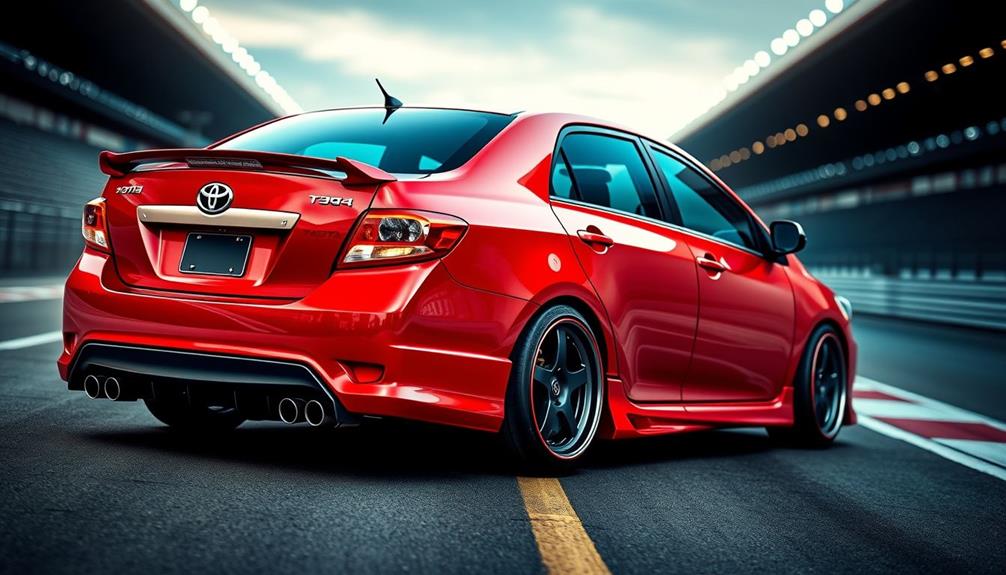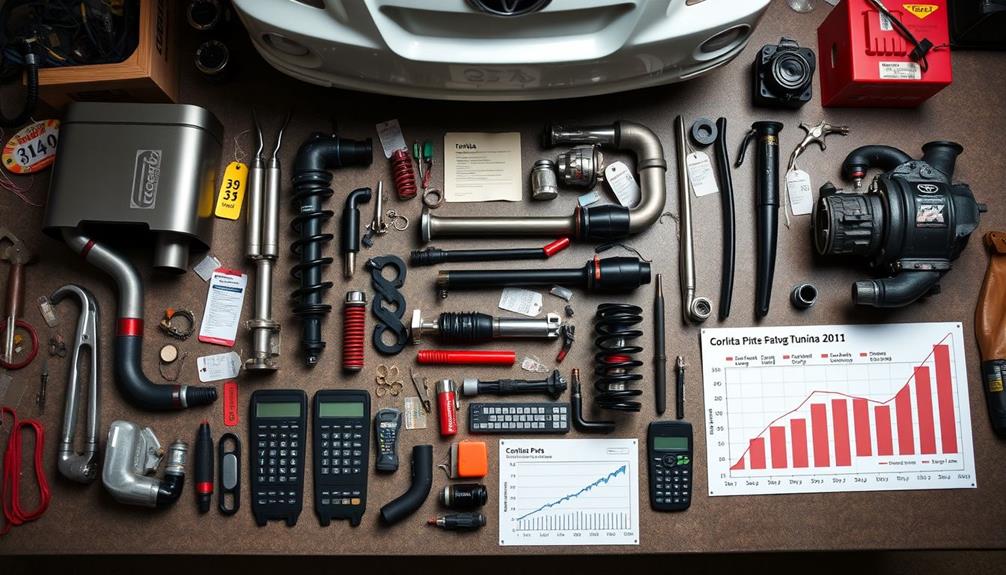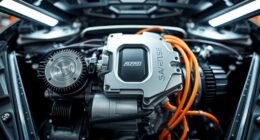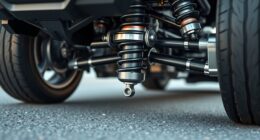You can transform your 2011 Toyota Corolla into a performance beast by focusing on essential tuning modifications. Start with a cold air intake and a performance exhaust system to enhance airflow and increase horsepower by 10-15 hp. Contemplate remapping the ECU or using a piggyback ECU like AEM FIC for improved engine management. If you're feeling adventurous, a turbo kit can elevate your power to around 225 hp. Remember to maintain regular upkeep to guarantee your engine's health throughout the process. There's more to contemplate that'll help you maximize your gains without compromising reliability.
Key Takeaways
- Upgrade to a cold air intake and performance exhaust system to increase airflow and gain 10-15 hp.
- Consider installing a piggyback ECU like AEM FIC for customizable power delivery while maintaining engine reliability.
- A quality turbo kit can elevate power output to 225 hp, significantly enhancing acceleration and performance.
- Regularly verify engine condition and conduct maintenance to ensure optimal performance before any modifications.
- Engage with tuning communities for insights and recommendations on effective modifications and installations.
Engine Tuning Fundamentals
When tuning the engine of your 2011 Toyota Corolla, understanding the fundamentals is key to releasing its potential. Engine tuning can greatly increase your Corolla's horsepower, which typically sits at 132 hp, through methods like ECU modifications and dyno tuning.
To get started, consider installing a cold air intake and a performance exhaust system. These upgrades enhance airflow and exhaust flow, laying the groundwork for improved performance.
A piggyback ECU, like the AEM FIC, offers additional tuning options, giving you the flexibility to customize power delivery to suit your needs.
If you're looking for a more dramatic boost, turbocharging can elevate your Corolla's output to an impressive 225 hp at the wheels. However, it's essential to assess the engine's integrity and reliability before diving into such considerable modifications.
Enhancing Power and Performance

Enhancing the power and performance of your 2011 Toyota Corolla involves strategic modifications that can transform your driving experience. One of the most effective upgrades is installing a quality turbo kit, which can elevate your Corolla's power output to an impressive 225 hp at the wheels, a significant leap from the stock 132 hp. This boost not only enhances acceleration but also adds excitement to your daily drive.
To optimize these gains, consider performance modifications like cold air intakes and exhaust upgrades. These changes improve airflow and contribute to better dyno tuning results, typically yielding an additional 10-15 hp.
While you're tuning, utilizing a piggyback ECU, such as the AEM FIC, can help fine-tune your engine's performance while ensuring you maintain factory reliability and drivability.
Keep in mind, though, that enhancing power can lead to decreased fuel efficiency. It's crucial to weigh the trade-offs between performance gains and your everyday driving needs.
With the right modifications, you can create a Toyota Corolla that not only looks good but also performs like a true performance beast on the road.
Essential Modifications for Tuning

To access the full potential of your 2011 Toyota Corolla, focusing on essential modifications is key.
Start by installing a cold air intake; this upgrade increases airflow to the engine and can boost horsepower by up to 10-15 hp.
Next, consider upgrading to a performance exhaust system. This modification enhances exhaust flow, improving engine efficiency and sound while offering slight power gains.
For more precise tuning, utilize an AEM FIC as a piggyback ECU. This device provides you with the flexibility to adjust fuel maps and ignition timing, allowing your engine to perform at its best.
If you're looking for a significant power increase, adding a quality turbo kit is a game-changer. Depending on other modifications, a turbo kit can elevate your power output to around 225 hp at the wheels.
Before diving into these modifications, verify your engine is in good health through regular maintenance. This step is vital to prevent potential damage and maximize your performance gains.
With these essential modifications, you'll transform your Corolla into a true performance beast that's ready to hit the road with power and precision.
Community Insights and Experiences

The vibrant Toyota Corolla community is filled with enthusiasts eager to share their tuning journeys and insights. If you own a Corolla S, you'll quickly discover that many members recommend adding cold air intakes and performance exhaust systems to enhance power and responsiveness.
These upgrades can bring your sedan to life, making driving a more exhilarating experience. Many users have reported impressive results after installing Unichip tuning systems, with gains of around +19whp and +10lb-ft torque. Such improvements can greatly elevate your vehicle's performance. Additionally, by fine-tuning various engine parameters, these enhancements offer smoother throttle response and improved fuel efficiency. For those looking to push the envelope even further, there are also several **BMW X6 tuning options** available, providing similar or even greater performance benefits. Whether it’s a sedan or an SUV, modern tuning solutions can unlock a vehicle’s true potential, giving drivers the thrill they seek.
You might also want to take into account throttle controllers like Sprint Booster, which have been praised for reducing throttle lag and improving acceleration response in 2011 Corolla models.
However, it's vital to remember the importance of proper installation and tuning. Owners emphasize that maintaining engine health is key to achieving peak performance without sacrificing reliability.
Engaging in community discussions can help you weigh the benefits of minor modifications against the costs of more extensive upgrades. By tapping into these shared experiences, you can make informed decisions that align with your performance goals.
Cost Analysis of Upgrades

When you're considering upgrades for your 2011 Corolla, it's essential to weigh your initial investment against potential long-term maintenance costs.
While some modifications might seem affordable upfront, they could lead to higher expenses down the line.
Plus, you should ask yourself if the performance gains justify the money spent compared to simply buying a higher-performance vehicle.
Initial Investment Considerations
Investing in tuning your 2011 Toyota Corolla can range widely, with initial costs typically between $300 to $1,500 depending on the modifications you choose.
Basic performance upgrades like a cold air intake and an upgraded exhaust system can be done for around $200 to $600, giving you modest power gains without a significant financial commitment. If you're considering more extensive tuning, options like ECU remapping can also fall within this budget.
However, if you're looking to turbocharge your Corolla, be prepared for a hefty investment, as quality turbo kits can cost between $3,000 to $5,000. This price tag includes necessary supporting modifications to guarantee reliability.
When contemplating your initial investment considerations, it's crucial to compare the costs of various performance upgrades. Some modifications, such as suspension enhancements or wheel/tire upgrades, may provide better performance per dollar spent compared to engine tuning alone.
Ultimately, you'll want to find the right balance between your budget and the performance gains you aim to achieve with your Toyota Corolla tuning.
Long-term Maintenance Expenses
Tuning your 2011 Toyota Corolla can enhance performance, but it's important to contemplate the long-term maintenance expenses that come with these upgrades. As you modify your sedan, be prepared for increased long-term maintenance costs due to potential engine wear. Depending on the modifications made, you might see expenses rise by 10-20%.
Here are some key points to keep in mind:
- Higher regular maintenance expenses: You'll likely need to use higher-quality fuel and change your oil more frequently, as performance upgrades demand better lubrication and cooling systems.
- Component durability: Parts like clutches and transmissions may wear out faster under increased power outputs. Budget for potential repairs or replacements, which could cost you $1,000 or more.
- Investment vs. gains: Weigh the cost-effectiveness of your tuning against the expected performance gains, as minor modifications may yield minimal improvements relative to their long-term financial impact.
Cost Vs. Performance Gains
Evaluating the cost versus performance gains of upgrades for your 2011 Toyota Corolla is vital for making informed decisions. Understanding how much you're willing to spend and what you hope to achieve in horsepower can guide your tuning journey.
| Upgrade Type | Cost Range | Expected Horsepower Gain |
|---|---|---|
| Cold Air Intake & Exhaust | $200 – $1,000 | 5 – 15 hp |
| Piggyback ECU (e.g., AEM FIC) | $400 – $800 | 10 – 20 hp |
| Turbo Kit | $3,000 – $5,000 | Modest gains |
While performance upgrades like a cold air intake and exhaust system are affordable, the gains might not justify the cost. A piggyback ECU can provide a better cost-to-performance ratio, improving your horsepower greatly without breaking the bank. However, installing a turbo kit, though promising more power, can be a hefty investment for modest returns.
Always factor in regular maintenance and engine health before diving into aggressive tuning. A well-maintained engine will help mitigate long-term costs associated with performance upgrades. Balancing cost and performance is essential to guarantee you get the driving experience you desire without overspending.
Recommendations for Optimal Tuning

Before you start tuning your 2011 Toyota Corolla, make sure you've got the essential preparations in place, like checking your current modifications and overall vehicle condition.
Choosing the right equipment, such as a cold air intake or performance exhaust, can set the foundation for ideal performance gains.
With the right approach, you'll maximize your Corolla's potential efficiently.
Essential Pre-Tuning Preparations
Ensuring your 2011 Toyota Corolla is in peak condition is essential for successful tuning. Before diving into performance modifications, focus on the pre-tuning preparations that will set you up for the best results.
Start by checking your engine health; regular maintenance like oil changes and spark plug replacements can prevent issues down the line.
- Install a cold air intake for improved airflow.
- Consider a performance exhaust system to enhance exhaust flow.
- Engage with a community dedicated to Toyota tuning for tips and recommendations.
Choosing the Right Equipment
When it comes to tuning your 2011 Toyota Corolla, selecting the right equipment is essential for maximizing performance. Start with an AEM FIC, which serves as either a piggyback or standalone ECU, effectively managing your performance modifications. Pairing this with a cold air intake can considerably boost airflow to the engine, potentially adding 5-10 hp.
Next, consider a quality performance exhaust system. This upgrade not only enhances your car's sound but can contribute to an additional 5-15 hp increase. Finally, utilizing a dyno tuning service allows for precise ECU adjustments, yielding performance gains of about 10-20 hp based on your existing modifications.
To help you choose the best options, here's a handy table:
| Equipment | Potential HP Gain | Benefits |
|---|---|---|
| AEM FIC | 0-20 | ECU management |
| Cold Air Intake | 5-10 | Improved airflow |
| Performance Exhaust | 5-15 | Enhanced sound & power |
| Dyno Tuning | 10-20 | Precision adjustments |
| Premium Fuel | Varies | Supports higher tuning gains |
These components will set you on the right path toward transforming your Corolla into a performance beast.
Frequently Asked Questions
How Can I Make My Toyota Corolla Faster?
To make your car faster, consider upgrading airflow with a cold air intake and performance exhaust. You might also explore tuning options like a piggyback ECU or turbocharging for significant power gains. Keep your engine maintained!
Can a Toyota Corolla Be Tuned?
You might think tuning's only for sports cars, but yes, you can tune a Toyota Corolla. With the right modifications, you'll boost performance, enhancing your driving experience and unleashing more power from your sedan.
How to Make a Toyota Corolla Louder?
To make your Corolla louder, consider upgrading to a performance exhaust system, installing a high-flow muffler, and adding a cold air intake. Removing the resonator can also boost sound, but be cautious of potential drone.
What Mods Can I Do to a Toyota Corolla?
If your Corolla's a sleeping giant, wake it up with mods! You can boost performance by adding a cold air intake, upgrading the exhaust, or even exploring a turbocharger for serious horsepower gains.
Conclusion
To sum up, tuning your 2011 Toyota Corolla can truly transform it into a performance beast. With the right modifications, you could boost your horsepower by up to 30%, making your sedan not just a daily driver but a thrilling ride. Remember, the journey of tuning is as exciting as the end result, so take your time and enjoy the process. Connect with fellow enthusiasts and share your experiences; you never know what inspiration you'll find!









